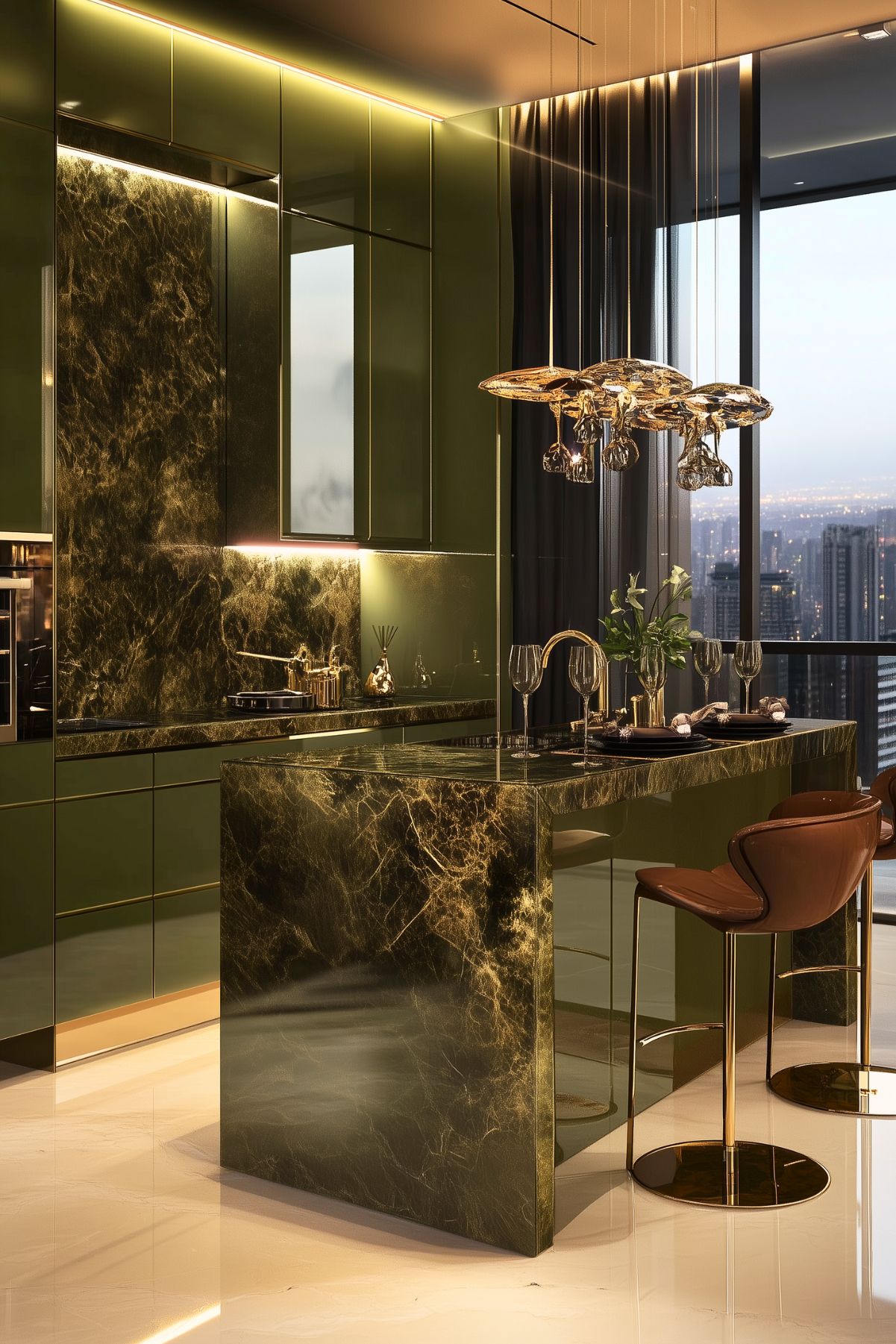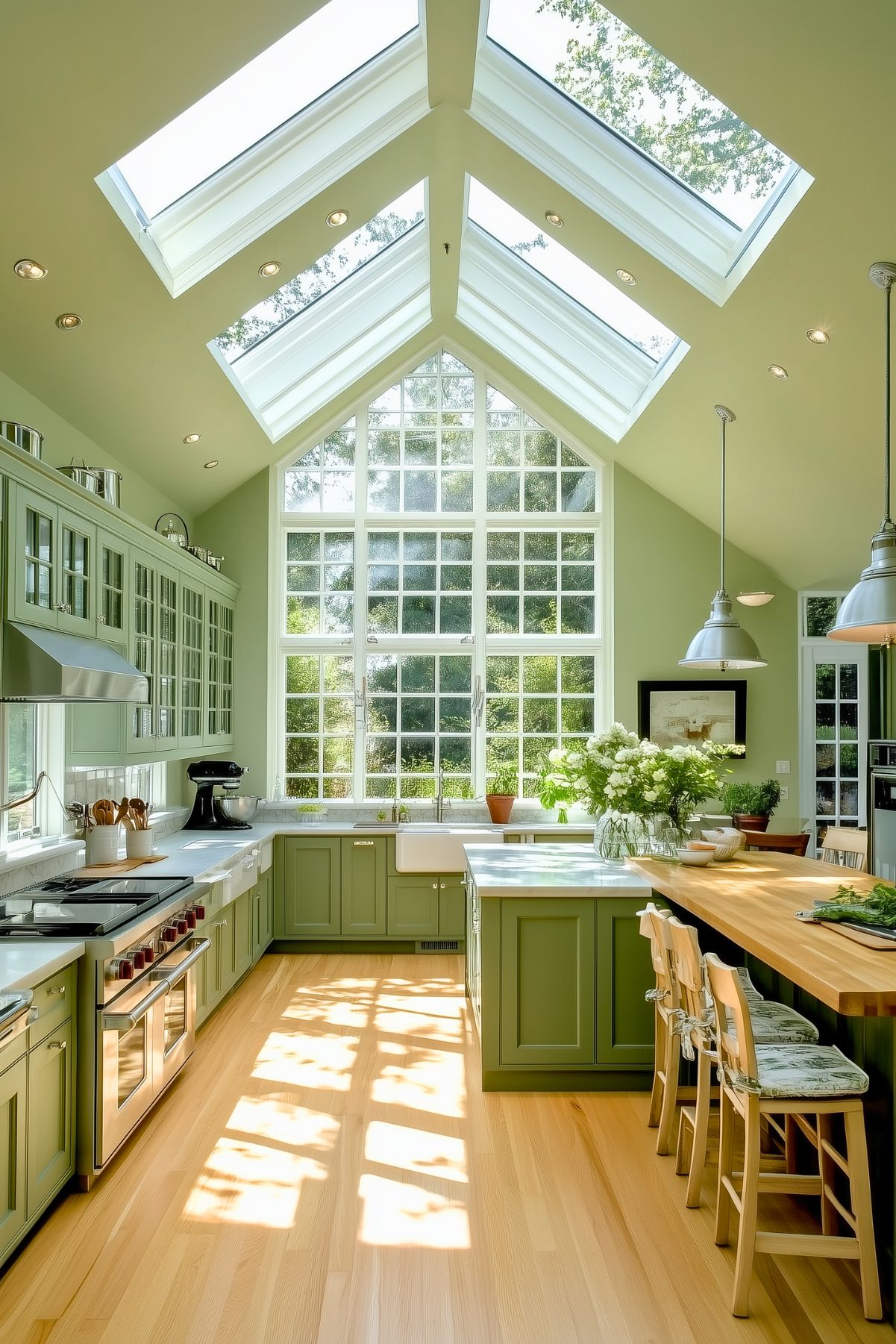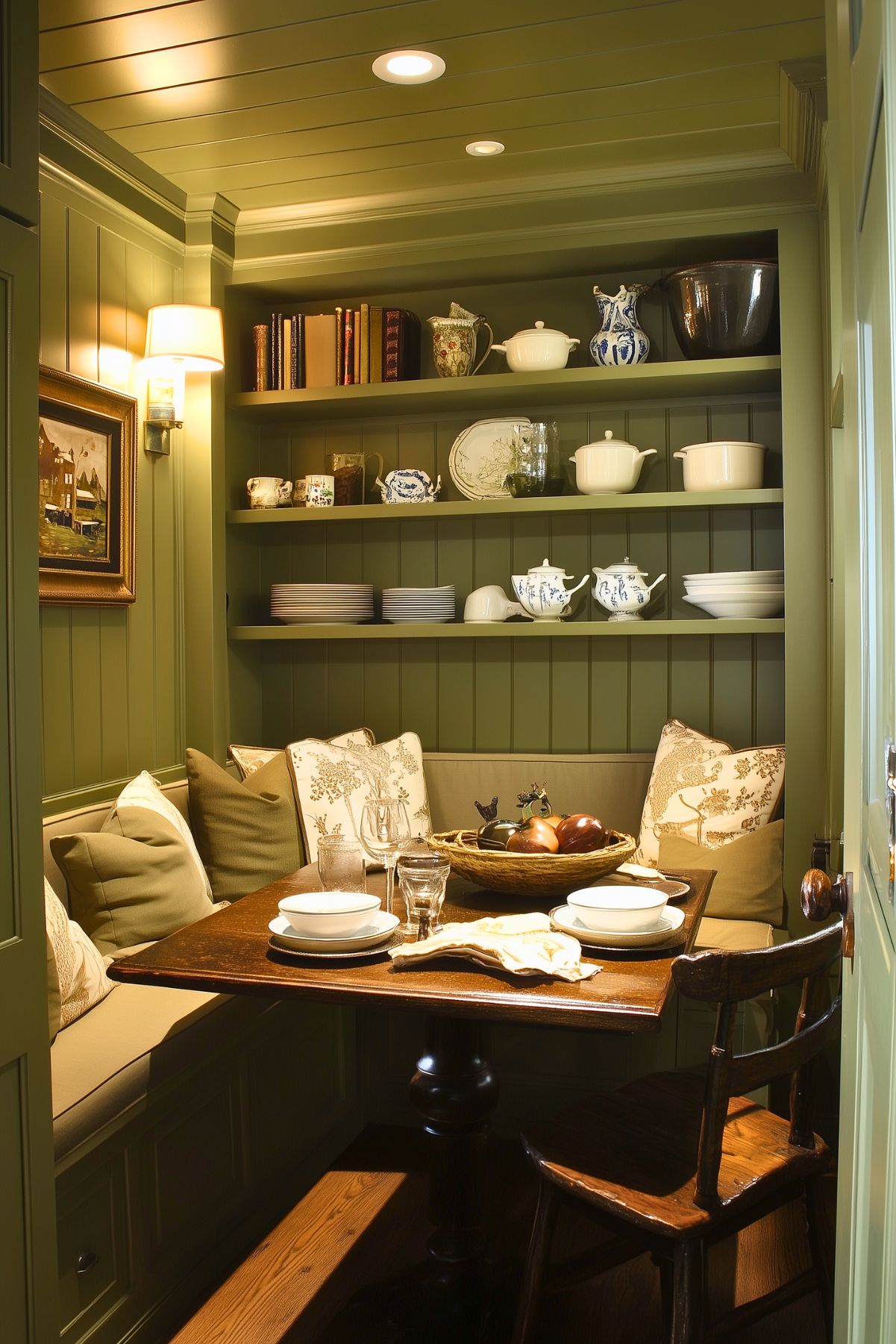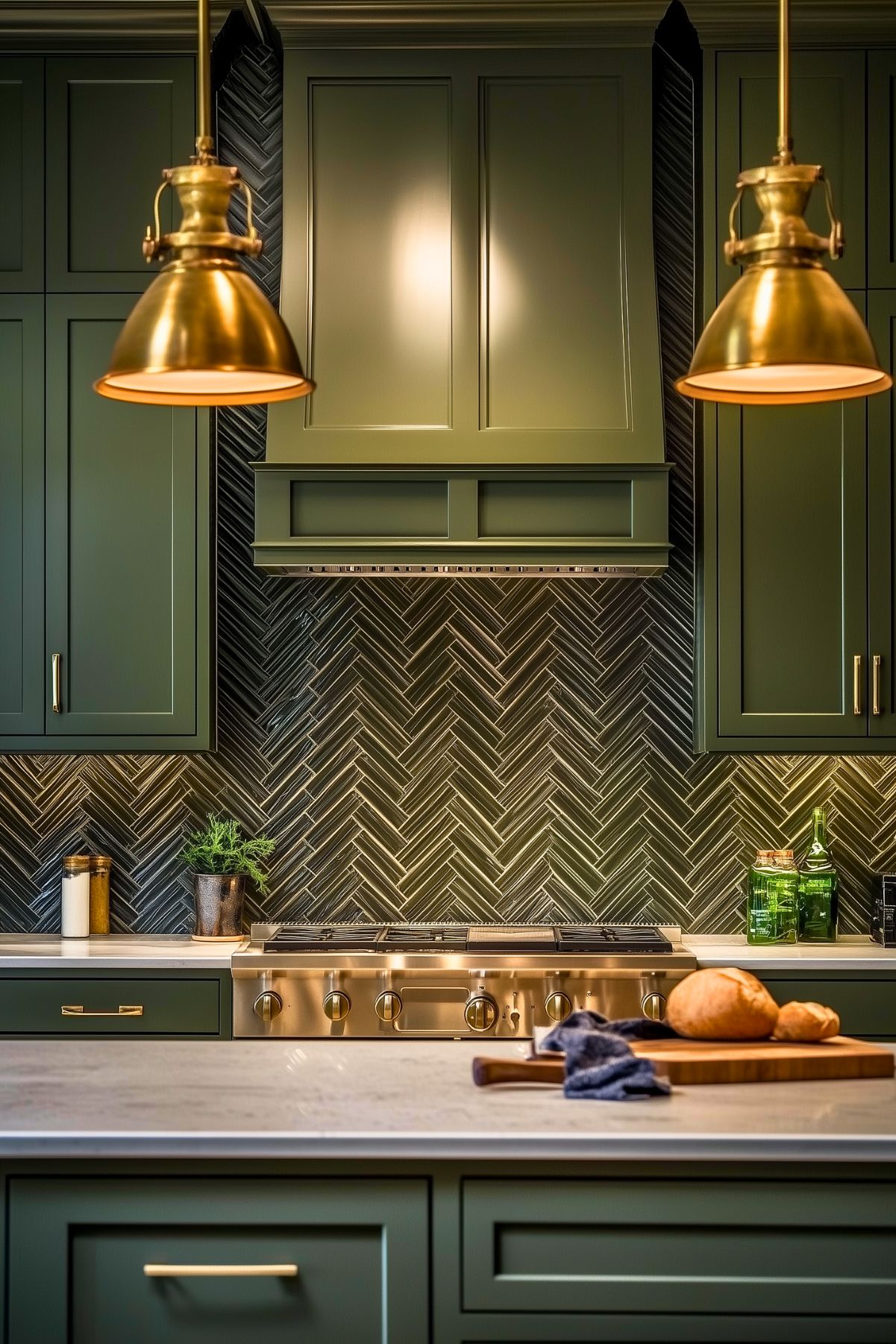Olive green kitchens have been gaining popularity in recent years as homeowners seek to bring the warmth of nature’s palette into their homes.
This rich, earthy color is both versatile and timeless, making it a great choice for kitchen design.
Whether you’re going for a modern, minimalist look or a cozy, rustic feel, olive green can work with a variety of styles.

One of the main appeals of olive green is its ability to create a calming and inviting atmosphere in the kitchen. This color is reminiscent of nature and can evoke feelings of peace and tranquility.
Olive green pairs well with a variety of other colors, from warm wood tones to cool blues and grays.
This makes it easy to incorporate into existing kitchen decor or to use as a starting point for a full kitchen renovation.
Key Takeaways
- Olive green is a versatile and timeless color choice for kitchen design that can work with a variety of styles.
- This rich, earthy color can create a calming and inviting atmosphere in the kitchen, evoking feelings of peace and tranquility.
- Olive green pairs well with a variety of other colors, making it easy to incorporate into existing kitchen decor or to use as a starting point for a full kitchen renovation.
The Allure of Olive Green in Kitchen Design

Olive green is a warm and earthy color that evokes a sense of calmness and serenity. It is a versatile color that can be used in various elements of kitchen design, from cabinets to backsplashes and countertops.
Olive green is a popular choice for homeowners who want to create a cozy and inviting space that reflects the beauty of nature.
One of the reasons why olive green is so appealing in kitchen design is its ability to bring warmth to the space.
Unlike cooler colors like blue or gray, olive green has a warm undertone that makes the kitchen feel more inviting and comfortable.
It is a color that can be used in both traditional and modern kitchen designs, making it a versatile choice for any style.
Another benefit of olive green in kitchen design is its ability to complement other colors. Olive green pairs well with a variety of colors, including white, beige, gold, and even black.
This makes it easy to create a cohesive color scheme that ties all the elements of the kitchen together.
When it comes to incorporating olive green into kitchen design, there are many ways to do so. One option is to use olive green cabinets, which can be paired with a neutral countertop and backsplash to create a balanced look.
Another option is to use olive green as an accent color, such as in a backsplash or on the kitchen island.
Olive green is a beautiful and versatile color that can add warmth and beauty to any kitchen design.
Whether used as the main color or as an accent, it is a color that is sure to create a cozy and inviting space that homeowners will love.
Planning Your Olive Green Kitchen

When planning an olive green kitchen, it is important to consider various factors such as the shade of olive green, balance of color with natural elements, and selection of materials and textures.
Choosing the Right Shade of Olive Green
Olive green comes in different shades, ranging from light to dark. When choosing the right shade for your kitchen, it is important to consider the amount of natural light that enters the space.
Lighter shades of olive green work well in kitchens with ample natural light, while darker shades of olive green work well in kitchens with less natural light.
Balancing Color with Natural Elements
To balance the color of an olive green kitchen, it is important to incorporate natural elements such as wood, stone, and metal.
Wooden cabinets, stone countertops, and metal appliances can help create a harmonious balance with the olive green color.
Selecting Materials and Textures
When selecting materials and textures for an olive green kitchen, it is important to consider the overall aesthetic and functionality of the space.
For instance, matte finishes can help create a more rustic or vintage look, while glossy finishes can create a more modern or contemporary look.
Similarly, textured finishes such as brushed metal or natural stone can add depth and visual interest to the space.
Planning an olive green kitchen requires careful consideration of factors such as shade of olive green, balance of color with natural elements, and selection of materials and textures.
By taking these factors into account, homeowners can create a beautiful and functional kitchen that embraces the warmth of nature’s palette.
Cabinetry and Countertops in Olive Green

Olive green is a versatile color that can add warmth and elegance to any kitchen.
When it comes to cabinetry and countertops, there are many options to choose from that can help you achieve the desired look and feel.
Cabinet Finishes and Styles
Olive green cabinets come in a variety of finishes and styles to fit any kitchen design. One popular option is two-tone cabinets, where the upper portion is painted white with glass panels and small round knobs, while the lower cabinets are painted in a dark olive green shade with more prominent hardware.
This combination adds depth and elegance to the kitchen.
Another popular option is to use olive green cabinets as an accent color, pairing them with white or light-colored cabinets. This creates a striking contrast and adds visual interest to the kitchen.
For a more traditional look, olive green cabinets with raised panel doors and ornate hardware can add a touch of sophistication to the kitchen. Flat panel doors with a matte finish can also create a modern and sleek look.
Countertop Materials and Hues
When it comes to countertops, there are many materials and hues that can complement olive green cabinets.
Marble and granite countertops in shades of white, beige, or cream can create a classic and timeless look.
For a more modern look, concrete or quartz countertops in shades of gray or black can provide a striking contrast to the olive green cabinets.
Wood countertops can also work well with olive green cabinets, especially in a rustic or farmhouse-style kitchen.
Light-colored wood, such as birch or maple, can add warmth and texture to the kitchen.
In terms of hues, warm-toned countertops can complement the earthy tones of olive green cabinets. Shades of beige, cream, and brown can create a cohesive and inviting look.
Cooler-toned countertops, such as gray or blue, can provide a contrasting element and add visual interest to the kitchen.
When choosing cabinetry and countertops in olive green, it’s important to consider the overall style and design of the kitchen. With the right combination of finishes, styles, and hues, olive green can add warmth and sophistication to any kitchen.
Olive Green Kitchen Appliances and Fixtures

When designing an olive green kitchen, it is important to carefully consider the appliances and fixtures to ensure that they complement the cabinetry and create a cohesive look.
Here are some tips for selecting the right appliances and fixtures for an olive green kitchen.
Coordinating Appliances with Cabinetry
Stainless steel appliances are a popular choice for many kitchens, but they may not be the best option for an olive green kitchen.
Instead, consider choosing appliances in a complementary color, such as black or white. Another option is to select appliances with a matte finish, which can add texture and depth to the space.
When selecting appliances, it is also important to consider their size and placement. Large appliances, such as refrigerators and stoves, can be major focal points in a kitchen.
So, it’s important to ensure that they are in proportion to the space and do not overwhelm the other design elements.
Selecting Fixtures and Hardware
In addition to appliances, fixtures and hardware are also important design elements to consider in an olive green kitchen.
When selecting these items, it is important to choose finishes that complement the cabinetry and other design elements.
For example, oil-rubbed bronze or brass fixtures can add warmth and depth to an olive green kitchen, while chrome or polished nickel can create a more modern look.
It is also important to consider the style of the fixtures, such as whether they are sleek and modern or more traditional in design.
When selecting hardware, it is important to choose pieces that are in proportion to the cabinetry and other design elements.
Oversized hardware can look out of place in a small kitchen, while tiny knobs may get lost on larger cabinets.
By carefully considering the appliances and fixtures in an olive green kitchen, it is possible to create a cohesive and inviting space that embraces the warmth and beauty of nature’s palette.
Lighting and Accessories

Layering Light for Ambiance
When it comes to creating a warm and inviting atmosphere in an olive green kitchen, lighting plays a crucial role.
Layering light is an effective way to add depth and ambiance to your kitchen. Start with a central ceiling fixture that provides general lighting for the space.
Then, add task lighting under cabinets and above the sink to provide ample illumination for cooking and cleaning.
To create a cozy and intimate feel, consider adding accent lighting. This could include pendant lights over the island or a chandelier over the dining table.
When selecting light fixtures, keep in mind that warm-toned bulbs will enhance the warmth of the olive green color palette.
Decorative Accessories and Accents
Accessories and accents are the perfect finishing touches for an olive green kitchen. These items can be used to add texture, color, and personality to the space.
Consider incorporating natural materials like wood and stone to complement the warmth of the olive green cabinets.
For a pop of color, add decorative accessories like vases, bowls, and artwork in complementary shades of blue or yellow.
Metallic accents like copper or brass can also add a touch of glamour to the space.
When selecting accessories, keep in mind that less is often more. Too many decorative items can clutter the space and detract from the beauty of the olive green cabinets.
Choose a few statement pieces that will enhance the overall aesthetic of the kitchen.









You May Also Like:






